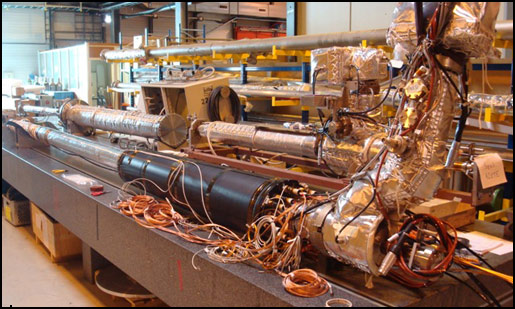
ATLAS e-News
23 February 2011
News from the pit
7 April 2008

The LUCID detectors integrated on the vacuum pipe sitting in the vacuum lab, ready for installation.
The beam pipe runs deep through the heart of ATLAS - it is the interface between the accelerator and the detector. It is inside the pipe that the particles circulate and finally collide. The CERN vacuum team, led by Ray Veness, has taken on the very difficult task of designing, assembling and installing the beam pipes on ATLAS and the other experiments around the LHC.
The last two pieces of the ATLAS beam pipe will be assembled between the monoblock and the toroid end cap in May, going inside the JF forward shield. The finalisation of the vacuum piping will be a major landmark in the commissioning of both the ATLAS detector and the LHC, as these last components will not only leave ATLAS ready for beams, but will also close the vacuum system around the LHC.
This assembly is a process that will require a high degree of precision. To make sure that everything goes well during the real installation, the vacuum team did a test in the vacuum lab last January: “It is a relatively complex assembly of a vacuum chamber, with pumps and vacuum gauges and bellows inside a conical support tube,” says Ray. Sitting in the vacuum lab waiting for installation, the LUCID detectors have also been integrated between the chamber and the support cone.
The vacuum team is now following the closure of the ATLAS detector. When the toroid is closed, they will be able to assemble the final piece and complete the vacuum pipe. As this piece is part of both the ATLAS and the LHC, the sense of responsibility that Ray and his colleagues at the vacuum team feel is well justified: “This installation is essential not only for the completion of ATLAS but also for the start-up of the LHC machine,” he says.
Transparent material
But there are other technical difficulties that the vacuum team had to take into account during the design of the vacuum chambers around the LHC. Within ATLAS, the beam pipe passes through the inner detector. As the particles collide in the pipe, it is essential that the material of the pipe be transparent to the detector: “We had to make sure the pipe does not interfere with the physics,” Ray explains. “Otherwise the detector would not see the particles coming out of the collisions.”
To meet the transparency needs, the segment of the beam pipe that goes all the way through the pixel detector is made out of beryllium. It was chosen due to its light nucleus, which makes the material transparent. Beryllium has also very good mechanical properties and it is leak-tight under vacuum.
In addition to the beryllium chamber, there are another six beam pipes inside the ATLAS detector. While the beryllium chamber goes right inside the pixel detector, the rest of the chambers take symmetrical positions. Two vacuum chambers are located in the end-cap calorimeters, two others in the end-cap toroid magnets and another two inside the forward shielding which lies at the heart of the LUCID detectors.

Mumu attempted to put together the last pieces of the vacuum pipe but had to give up. Way too complex!
As the beam pipes are the interface of ATLAS and the LHC, they have to meet the requirements of both. While ATLAS requires the most transparent chamber possible, the LHC needs a strong, reliable beam pipe with no leaks. The vacuum team has so far succeeded in delivering new technologies that respond to the different needs. Despite the difficulties of understanding the type of technologies that work better for each purpose, this has been one of the parts of the job that Ray has enjoyed the most: “Working with both ATLAS and LHC physicists, and trying to find solutions that satisfy both, has been very interesting,” Ray says.
